Rodrigues rail
| Rodrigues rail | |
|---|---|
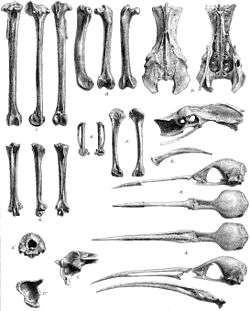 | |
| Subfossil bones, 1879 | |
| Scientific classification | |
| Kingdom: | Animalia |
| Phylum: | Chordata |
| Class: | Aves |
| Order: | Gruiformes |
| Family: | Rallidae |
| Genus: | Erythromachus |
| Species: | E. leguati |
| Binomial name | |
| Erythromachus leguati Milne-Edwards, 1874 | |
| | |
| Former range | |
| Synonyms | |
|
List
| |
The Rodrigues rail or Leguat's gelinote (Erythromachus leguati) is an extinct, flightless rail that was endemic to the Mascarene island of Rodrigues, east of Madagascar in the Indian Ocean. It was described as having grey plumage, a red beak, red legs, and a naked red patch around the eye. The beak varied between specimens from straight to curved, but the reason for this is unknown.
It is sometimes assigned to the genus Aphanapteryx, along with its close relative the red rail (A. bonasia) of Mauritius, but they are commonly kept separate. Its relationship with other rails is unclear. It was described as being attracted to red objects, which humans exploited while hunting it.
The Rodrigues rail is believed to have become extinct in the mid-18th century because of destruction of its habitat and predation by humans and introduced animals. Apart from information gathered from subfossil bones, the bird is poorly understood and is only known from two contemporaneous descriptions, and there are no extant illustrations of it. The bird was first described by François Leguat, a French Huguenot refugee marooned on Rodrigues in 1691, and was named leguati in his honour. The second description is by Julien Tafforet, also marooned on the island in 1726. Subfossil remains were first described and connected with the extant descriptions in 1874.
Taxonomy
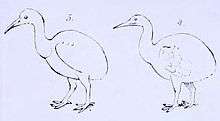
In 1848, Hugh Strickland wrote that a bird similar to the red rail (Aphanapteryx bonasia) of Mauritius was mentioned in François Leguat's memoirs, but was unable to classify it further because of a lack of remains. He wrote that it may have been a grouse or gallinaceous bird.[2] In 1874, Alphonse Milne-Edwards connected Leguat's and Tafforet's descriptions with some bones found in a cave on Rodrigues, and recognised their similarity to those of the red rail.[3] Milne-Edwards coined the generic name Erthyromachus from the Greek words for "red" and "battle", in reference to its behaviour towards red objects, and the specific name is in honour of Leguat. The junior synonym Miserythrus, from "red" and "hatred", was coined by Alfred Newton in 1893, also referring to this behaviour.[4] James Greenway wrote that Leguat's description referred to wind-blown purple swamphen.[5] This has not been accepted by other authors.[6] More remains were found in 1974.[7]
Unlike the red rail and other extinct Mascarene birds, the Rodrigues rail was not illustrated by contemporaneous artists. Ornithologist Storrs L. Olson described reconstructions made for Walter Rothschild's 1907 book Extinct Birds and Masauji Hachusika's The Dodo and Kindred Birds (1953) as "rather fanciful".[8] Frederick William Frohawk based his restoration in the former book on an outline sketch, which was in turn based on a 17th-century sketch drawn by Sir Thomas Herbert, which is now known to depict the red rail.[9] Hermann Schlegel thought it depicted a species of dodo (Didus herbertii) from Rodrigues when he drew the outline in 1854, and that it was the species mentioned by Leguat.[10]
Evolution
Apart from being a close relative to the red rail, the relationships of the Rodrigues rail are uncertain and the two are commonly listed as separate genera, Aphanapteryx and Erythromachus, but have sometimes been united as species of Aphanapteryx.[11] Edward Newton and Albert Günther first generically synonymised them in 1879 because of their skeletal similarities.[12] It has been suggested that because of these species' geographic locations and the morphology of the nasal bones, they may have been related to the genera Gallirallus, Dryolimnas, Atlantisia, and Rallus.[8] Rails have reached many oceanic archipelagos, which has frequently lead to speciation and the evolution of flightnessness. These rails may be of Asian origins, like many other Mascarene birds.[11]
Description
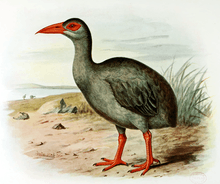
The Rodrigues rail was a plump, flightless rail with bright grey plumage, perhaps flecked with white, and it had a red bill and legs, and a red, naked area around its eyes. It was somewhat smaller than its closest relative, the red rail. The bird's exact length is unknown, but it was about the size of a chicken. The strong bill varied greatly in size and shape; some specimens had short and almost straight bills, and others had much longer bills that were prominently curved.[6] It is unknown whether this was related to sexual dimorphism or to individual variation. Its cranium was 38 millimetres (1.5 in) long by 20 millimetres (0.79 in) wide, and the bill was 77 millimetres (3.0 in) long. The pelvis was large and strongly built in proportion to the size of the bird.[12]
The Rodrigues rail had somewhat larger wings than the red rail, but the species' leg proportions, pelvis and sacrum was also similar.[12][13] It also had a proportionately longer humerus, a broader and shorter skull, and having longer and lower nostrils from the red rail, from which it differed considerably in plumage, based on early descriptions.[8]
Contemporary accounts
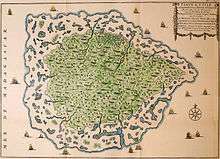
The Rodrigues rail was first recorded by François Leguat in his 1708 memoir, A New Voyage to the East Indies. Leguat was the leader of a group of nine French Huguenot refugees; the group were the first to colonise Rodrigues from 1691 to 1693, after they were marooned there by their captain.[14] Leguat's observations are considered some of the first cohesive accounts of animal behaviour in the wild.[11]
Leguat's full account of the bird reads as follows:
Our 'gelinotes' [hens] are fat all the year round and of a most delicate taste. Their colour is always of a bright grey, and there is very little difference in plumage between the two sexes. They hide their nests so well that we could not find them out, and consequently did not taste their eggs. They have a red naked area round their eyes, their beaks are straight and pointed, near two and two-fifths inches long, and red also. They cannot fly, their fat makes them too heavy for it. If you offer them anything red, they are so angry they will fly at you to catch it out of your hand, and in the heat of the combat we had an opportunity to take them with ease.[9]
Another description of appearance and behaviour is found in an anonymous document called Relation de l'Ile Rodrigue, which was rediscovered in 1874 and has been attributed to Julien Tafforet, who was marooned on Rodrigues in 1726:
There is a sort of bird, of the size of a young hen, which has the beak and feet red. Its beak is a little like that of a curlew, excepting that it is slightly thicker and not quite so long. It plumage is spotted with white and grey. They generally feed on the eggs of the land tortoises, which they find in the ground, which makes them so fat that they often have difficulty running. They are very good to eat, and their fat is of a yellowish red, which is excellent for pains. They have small pinions [wings], without feathers, on which account they cannot fly; but on the other hand, they run very well. Their cry is a continual whistling. When they see any one who pursues them they produce another sort of noise, like that of a person who has hiccups.[11]
Behaviour and ecology
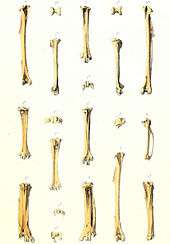
The Rodrigues rail ate invertebrates, possibly small vertebrates, and in the nesting season of the now extinct Cylindraspis tortoises, they dug up and fattened themselves on their eggs. It is possible that the birds had an annual cycle of becoming fat and slim, corresponding with varying availability of food throughout the year. Its vocalizations were a continuous whistling, and it had a hiccup-like, staccato alarm call.[15] Leguat wrote that the birds were hunted in similar method to that used on Mauritius to catch red rails: a piece of red cloth was shown to the birds, which responded with aggressive behaviour, jumping at the cloth and trying to tear it apart. They no fear of humans because they had evolved in the absence of predators, enabling hunters to catch them in large numbers. Neither Leguat or Tafforet located the eggs and nests of the birds.[11]
Many other species endemic to Rodrigues became extinct after humans arrived, and the island's ecosystem is heavily damaged. Before humans arrived, forests covered the island entirely, but very little remains today. The Rodrigues rail lived alongside other recently extinct birds, such as the Rodrigues solitaire, the Rodrigues parrot, Newton's parakeet, the Rodrigues starling, the Rodrigues owl, the Rodrigues night heron, and the Rodrigues pigeon. Extinct reptiles include the domed Rodrigues giant tortoise, the saddle-backed Rodrigues giant tortoise, and the Rodrigues day gecko.[16]
Extinction
The disappearance of the Rodrigues rail coincided with the tortoise trade between 1730 and 1750; traders burnt vegetation, hunted birds, and imported cats and pigs which preyed on eggs and chicks. The fat of birds that had been feeding on tortoise eggs was bright orange and was used as a remedy for people recovering from illness.[11] Although the Rodrigues rail survived predation by rats that were accidentally introduced in the late 17th century and had multiplied by the time of Leguat's visit, it was unable to withstand persecution by humans. Alexandre Guy Pingré wrote in his 1763 report that the bird was extinct by 1761.[15]
References
Footnotes
- ↑ BirdLife International 2012.
- ↑ Strickland & Melville 1848.
- ↑ Milne-Edwards 1874.
- ↑ Olson 1977, p. 361-363.
- ↑ Greenway, J. C. (1967). Extinct and Vanishing Birds of the World. New York: American Committee for International Wild Life Protection 13. pp. 117–119. ISBN 0486218694.
- 1 2 Fuller 2001.
- ↑ Cowles, G. S. (1987). "The fossil record". In Diamond, A. W. Studies of Mascarene Island Birds. Cambridge. pp. 90–100. doi:10.1017/CBO9780511735769.004. ISBN 9780511735769.
- 1 2 3 Olson 1977.
- 1 2 Rothschild 1907.
- ↑ Schlegel, H. (1854), "Ook een Woordje over den Dodo (Didus ineptus) en zijne Verwanten", Verslagen en Mededeelingen der Koninklijke Akademie van Wetenschappen (in Dutch), 2: 232–256
- 1 2 3 4 5 6 Cheke & Hume 2008.
- 1 2 3 Günther & Newton 1879.
- ↑ Newton & Gadow 1893.
- ↑ Leguat 1708, p. 71.
- 1 2 Hume & Walters 2012.
- ↑ Cheke & Hume 2008, p. 49–52.
Citations
- BirdLife International (2012). "Erythromachus leguati". IUCN Red List of Threatened Species. Version 2012.1. International Union for Conservation of Nature. Retrieved 11 September 2012.
- Cheke, Anthony S.; Hume, Julian Pender (2008). Lost Land of the Dodo: an Ecological History of Mauritius, Réunion & Rodrigues. New Haven and London: T. & A. D. Poyser. ISBN 978-0-7136-6544-4.
- Fuller, Errol (2001). Extinct Birds (revised ed.). New York: Comstock. ISBN 978-0-8014-3954-4.
- Günther, A.; Newton, E. (1879). "The extinct birds of Rodriguez". Philosophical Transactions of the Royal Society of London. 168: 423–437. doi:10.1098/rstl.1879.0043.
- Hume, Julian Pender; Walters, M. (2012). Extinct Birds. London: A & C Black. ISBN 978-1-4081-5725-1.
- Leguat, F. (1708). Voyages et Avantures de François Leguat & de ses Compagnons, en Deux Isles Desertes des Indes Orientales, etc. (2nd ed.). Amsterdam: Jean Louis de Lorme.
- Milne-Edwards, Alphonse (1874). "Recherches sur la faune ancienne des Îles Mascareignes". Annales Des Sciences Naturelles (Zoologie). 5: 19.
- Newton, E.; Gadow, H. (1893). "IX. On additional bones of the Dodo and other extinct birds of Mauritius obtained by Mr. Theodore Sauzier". The Transactions of the Zoological Society of London. 13 (7): 281–302. doi:10.1111/j.1469-7998.1893.tb00001.x.
- Olson, S. (1977). A synopsis on the fossil Rallidae In: Ripley, S. D.: Rails of the World – A Monograph of the Family Rallidae. Boston: Codline. ISBN 978-0-87474-804-8.
- Rothschild, Walter (1907). Extinct Birds. London: Hutchinson & Co.
- Strickland, Hugh Edwin; Melville, A. G. (1848). The Dodo and Its Kindred; or the History, Affinities, and Osteology of the Dodo, Solitaire, and Other Extinct Birds of the Islands Mauritius, Rodriguez, and Bourbon. London: Reeve, Benham and Reeve.
External links
 Media related to Erythromachus at Wikimedia Commons
Media related to Erythromachus at Wikimedia Commons Data related to Rallidae at Wikispecies
Data related to Rallidae at Wikispecies
